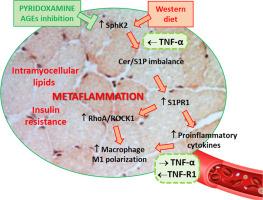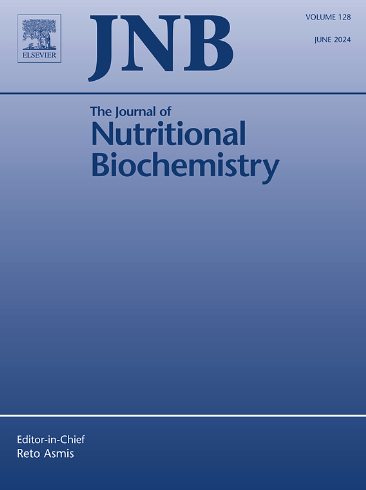Inhibition of advanced glycation end-products by the vitamin B6 vitamer pyridoxamine prevents systemic and skeletal muscle diet-induced metaflammation through modulation of S1P/RhoA/ROCK signalling
IF 4.9
2区 医学
Q1 BIOCHEMISTRY & MOLECULAR BIOLOGY
引用次数: 0
Abstract
The typical western diet contributes to the accumulation of Advanced Glycation End-products (AGEs), reactive compounds involved in metabolic alterations and low-grade inflammation, referred as metaflammation. AGEs affect sphingolipid metabolism increasing sphingosine-1-phosphate (S1P). S1P is in turn induces pro-inflammatory M1 macrophage polarization through activation of RhoA/ROCK. The current study seeks to determine whether inhibition of AGEs by the antiglycating vitamin B6 analog pyridoxamine prevents metaflammation via modulation of S1P/RhoA/ROCK signalling. Gastrocnemius muscle was obtained from mice fed a standard diet (SD) or a western diet (WD), supplemented or not with pyridoxamine (WD+PYR, 150mg/kg bw/day). Metabolic and inflammatory profiles have been investigated in plasma, while accumulation of AGE-modified proteins, expression of RAGE, S1P-synthesizing enzymes and S1P receptors, as well as activation of RhoA/ROCK/IRS-1 pathway have been analysed in gastrocnemius muscle. Markers of local inflammatory cells infiltration and macrophage polarization were also explored. In comparison to SD mice, WD mice developed obesity, glucose intolerance, and muscle lipid accumulation with increased plasma proinflammatory cytokines and muscle M1-polarized macrophage infiltration. WD mice muscle showed higher content of AGE-modified proteins with increased S1P synthesis and S1PR1 expression, paralleled by activation of RhoA/ROCK and impairment of insulin signalling. By inhibiting AGEs production through pyridoxamine supplementation, all the WD-induced metabolic and inflammatory signalling alterations were significantly reversed towards the SD state. The present findings confirm a relevant role for AGE/S1P/RhoA/ROCK signalling in diet-induced metaflammation, suggesting the formulation of pharmacological and nutraceutical tools to prevent AGEs accumulation as a useful strategy against obesity-related metabolic and inflammatory diseases.

维生素B6维生素pyridoxamine通过调节S1P/RhoA/ROCK信号传导抑制晚期糖基化终产物,防止全身和骨骼肌饮食诱导的炎症。
典型的西方饮食有助于晚期糖基化终产物(AGEs)的积累,这些活性化合物参与代谢改变和低度炎症,称为元炎症。AGEs影响鞘脂代谢,增加鞘脂素-1-磷酸(S1P)。S1P反过来通过激活RhoA/ROCK诱导促炎M1巨噬细胞极化。目前的研究旨在确定抗糖化维生素B6类似物吡哆沙胺是否通过调节S1P/RhoA/ROCK信号传导来抑制AGEs,从而防止复燃。小鼠分别饲喂标准日粮(SD)和西方日粮(WD),并分别添加或不添加吡哆胺(WD+PYR, 150mg/kg bw/day),获得腓肠肌。我们研究了血浆中的代谢和炎症谱,同时分析了腓肠肌中age修饰蛋白的积累、RAGE、S1P合成酶和S1P受体的表达以及RhoA/ROCK/IRS-1通路的激活。探讨局部炎症细胞浸润和巨噬细胞极化的标志物。与SD小鼠相比,WD小鼠出现肥胖、葡萄糖耐受不良和肌肉脂质积累,血浆促炎细胞因子和肌肉m1极化巨噬细胞浸润增加。WD小鼠肌肉中age修饰蛋白的含量较高,S1P合成和S1PR1表达增加,与RhoA/ROCK的激活和胰岛素信号通路受损有关。通过补充吡哆沙胺抑制AGEs的产生,所有wd诱导的代谢和炎症信号改变都被显著逆转至SD状态。目前的研究结果证实了AGE/S1P/RhoA/ROCK信号在饮食诱导的炎症中的相关作用,表明制定药理学和营养保健工具来防止AGEs积累作为对抗肥胖相关代谢和炎症性疾病的有用策略。
本文章由计算机程序翻译,如有差异,请以英文原文为准。
求助全文
约1分钟内获得全文
求助全文
来源期刊

Journal of Nutritional Biochemistry
医学-生化与分子生物学
CiteScore
9.50
自引率
3.60%
发文量
237
审稿时长
68 days
期刊介绍:
Devoted to advancements in nutritional sciences, The Journal of Nutritional Biochemistry presents experimental nutrition research as it relates to: biochemistry, molecular biology, toxicology, or physiology.
Rigorous reviews by an international editorial board of distinguished scientists ensure publication of the most current and key research being conducted in nutrition at the cellular, animal and human level. In addition to its monthly features of critical reviews and research articles, The Journal of Nutritional Biochemistry also periodically publishes emerging issues, experimental methods, and other types of articles.
 求助内容:
求助内容: 应助结果提醒方式:
应助结果提醒方式:


